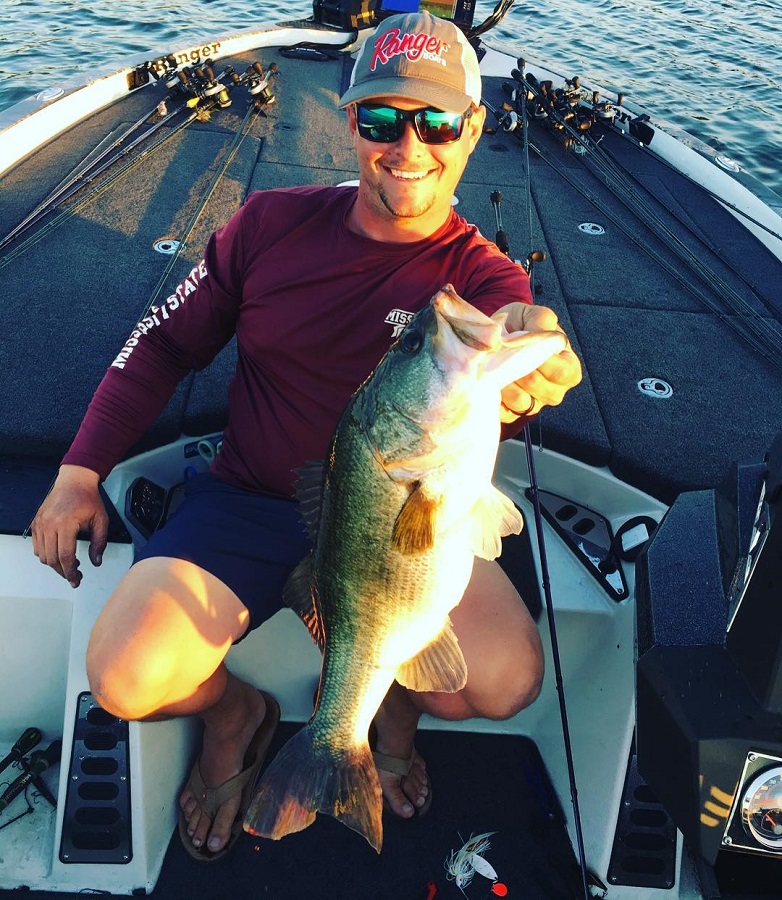 Springtime is one of the best times of year to catch quality and quantity of bass. The bass are in constant movement and all have one thing on their mind. To make the most of the shallow migration, 2017 Forrest Wood Cup Champion Justin Atkins has a specific approach to each of the segments of the spawn.
Springtime is one of the best times of year to catch quality and quantity of bass. The bass are in constant movement and all have one thing on their mind. To make the most of the shallow migration, 2017 Forrest Wood Cup Champion Justin Atkins has a specific approach to each of the segments of the spawn.
Pre-Spawn
Atkins feels that one of the best pre-spawn lures is a soft stick bait. He will use it three different ways depending on the situation. He will pitch it, cast it and wacky rig it.
 When he sees fish cruising, he says the wacky-rig is hard to beat.
When he sees fish cruising, he says the wacky-rig is hard to beat.
“When they are just coming up deeper water they are a little skittish and often just cruising. The General (Berkley Powerbait Maxscent) (shown top right and in video below) is a really good soft stick bait because it has a great action, it has a strong scent and the texture is perfect and natural,” he says.
He prefers spinning gear for the wacky rig.
“If I am fishing it Texas-rigged I prefer casting gear, but for the wacky rig I’ll use a 7’, medium Abu Garcia Fantasista Premier with a Revo Premier reel,” he says. He’ll spool it up with 8-pound Fireline Ultra 8 in the crystal color with an eight or 10-pound fluorocarbon leader.
To target pre-spawn bass and even those spawning near cover, he fishes The General with a 5/16-ounce weight and rigs I on a 3/0 Berkley Fusion19™ straight shank flipping hook.
“I’ll pitch it around reeds, brush, grass and any other type of cover. A lot of times the bass will spawn right on the edge of the grass and The General slides through cover really easily,” he adds.
READ RELATED: 4 Best Soft Swimbaits from Berkley
Sight Fishing
Fishing for spawning bass can be very easy or a big challenge. Each fish has a unique personality and they are all a little bit different from the next one. To combat this, Atkins has a range of different plastics he uses and switches them up based on the clues the fish are giving him.
 For aggressive fish, he likes a soft plastic with more aggressive movements.
For aggressive fish, he likes a soft plastic with more aggressive movements.
“The Chigger Craw is my favorite for bedding fish because it has a great action with tons of flapping from the claws. It is also a shorter plastic, which I really like for bedding fish because it is easier to hook them if they are just biting part of the bait,” he says.
If the fish are wary of his presence, he likes a Berkley Powerbait Maxscent Creature Hawg (shown bottom right) and chooses that bait for a few reasons.
“The scent is really strong and that can help if the fish are a little skittish. It also doesn't have too any appendages and it looks really natural in the water,” he says.
When targeting spawning fish, he likes to use heavy gear and believes it helps land more fish.
“It is just natural to want to set the hook really hard when you see the fish bite. With bed fishing, you are so close to the fish and too hard of a hookset can lead to snapping your line,” he says. “I rig up with 20 or 25-pound test Berkley Trilene 100% fluorocarbon and also like to use a heavier weight to keep the bait in the zone. I’ll use a 3/8-. or ½-ounce tungsten weight most of the time.”
 His rod and reel of choice are an Abu Garcia Villain 2.0 with a Revo STX reel.
His rod and reel of choice are an Abu Garcia Villain 2.0 with a Revo STX reel.
“I like the 7’6” models and will use a medium heavy or heavy depending on the size of the fish. If they are smaller fish in that body of water, I go with the medium heavy,” he adds.
READ RELATED: Light Lining with Justin Lucas
Post-Spawn
After the bass are done spawning they are worn out. They are sluggish, tired and hungry, but do not want to do too much to find a meal. With this in mind, Atkins likes a big profile bait that moves slowly. His top pick is a 10” Berkley Power Worm.
“I’ll have it rigged up after they spawn and will keep one rigged up until the fall,” he says.
After they spawn, Atkins likes to head offshore and fish brushpiles, offshore grass, points and shallow bars.
“They always relate to cover, but especially after they spawn. They just spend six weeks or so for the process of spawning so they want to recoup and get an easy meal,” he says.
He fishes the Power Worm on a 7’3”, heavy Abu Garcia Fantasista Premier with a 7.3:1 Revo STX and spools it with 20-pound Trilene 100% fluorocarbon for most applications.
“I will use a ¼ or 5/16 oz. weight and use a 5/0 Berkley Fusion19™ hook. The hooks are really sharp, but they are also really rigid and you do not roll over the hook points as much as you do with other brands,” says Atkins.
Each of the segments of the spawn requires a different approach, but Atkin's choice of soft plastics can play a role in success throughout the spring months.


 Advertising
Advertising